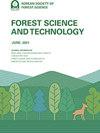Productivity of highland bamboo (Yushania alpina) across different plantation niches in West Amhara, Ethiopia
IF 2.2
Q2 FORESTRY
引用次数: 18
Abstract
Abstract Highland bamboo as part of Agroforestry practice is planted and managed by farmers in various plantation niches. However, the planation niches which are types of management on the productivity of bamboo is not yet understood. The research evaluates the impact of plantation niches on the productivity of highland bamboo in potential bamboo growing areas of West Amhara, Ethiopia. Farta, Banja, Dega Damot, and Sinan districts were selected for the study to represent potential highland bamboo growing areas in West Amhara. In each district, three kebeles (smaller administrative units in Ethiopia) were also selected based on their resource status and prevalence growing niches. Finally, a total of 324 sample plots were randomly selected over study areas for data collection. The Productivity and basal area of the bamboo stand were estimated by using DBH of the culm. Whereas the volume of bamboo stands was estimated using DBH, the height of culm breast, and total culm size. The diameter distribution of bamboo culms along plantation niches shows positively skewed between 4 and 8 cm ranges. The standing stock of culm ranges from 19,188 ± 336 culms ha−1 to 23,129 ± 390 culms ha−1 in woodlot and riverbank niches, respectively. The biomass storage capacity of highland bamboo varies from 92.2 ± 4.2 ton ha−1 to 118.6 ± 4.2 ton ha−1 total dry weight (TDW) from the roadside to riverbank plantation niches. Generally bamboo has a higher potential of accumulating huge dry weight, which is a good indicator of its potential for carbon sequestration and environmental protection. Therefore, it needs great attention from respective stakeholders to get twin benefits of bamboo as production and climate change mitigation.埃塞俄比亚西阿姆哈拉不同人工林生态位的高原竹生产力
高原竹作为农林业实践的一部分,由农民在不同的种植生态位种植和管理。然而,作为竹林生产力管理类型的林分生态位尚不清楚。本研究评估了埃塞俄比亚西阿姆哈拉潜在竹种植区人工林生态位对高原竹生产力的影响。研究选择了Farta、Banja、Dega Damot和Sinan地区作为西阿姆哈拉潜在的高地竹子种植区。在每个地区,还根据其资源状况和流行的生长利基选择了三个kebeles(埃塞俄比亚较小的行政单位)。最后,在研究区随机抽取324个样地进行数据收集。利用竹竿胸径估算了竹林的生产力和基材面积。而竹林的体积则是通过胸径、竿胸高和总竿长来估算的。竹竿直径沿人工林生态位分布在4 ~ 8 cm范围内呈正偏态。林地和河岸生态位的枯木存量分别为19,188±336 ~ 23,129±390。旱地竹林生态位的总干重(TDW)变化范围为92.2±4.2 ~ 118.6±4.2 t ha - 1。一般来说,竹子具有较高的干重积累潜力,这是其固碳和环保潜力的一个很好的指标。因此,需要相关利益相关者的高度关注,以获得竹子作为生产和减缓气候变化的双重效益。
本文章由计算机程序翻译,如有差异,请以英文原文为准。
求助全文
约1分钟内获得全文
求助全文

 求助内容:
求助内容: 应助结果提醒方式:
应助结果提醒方式:


